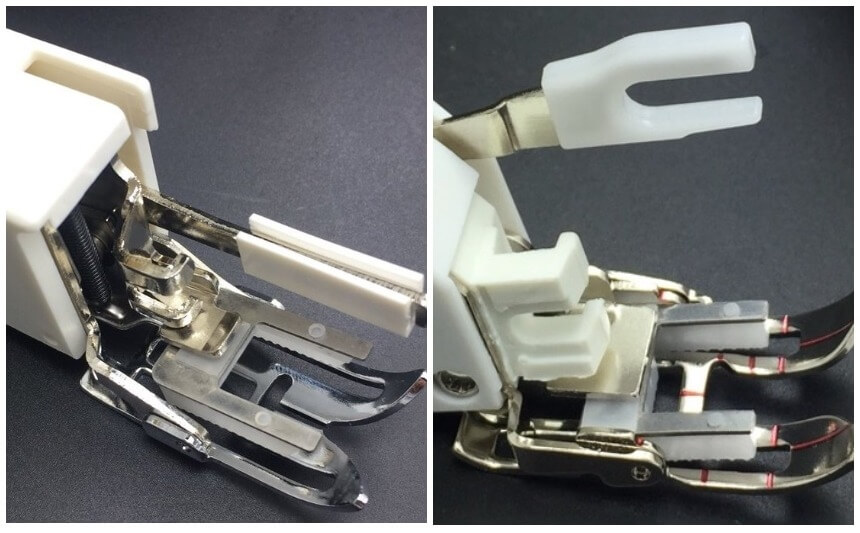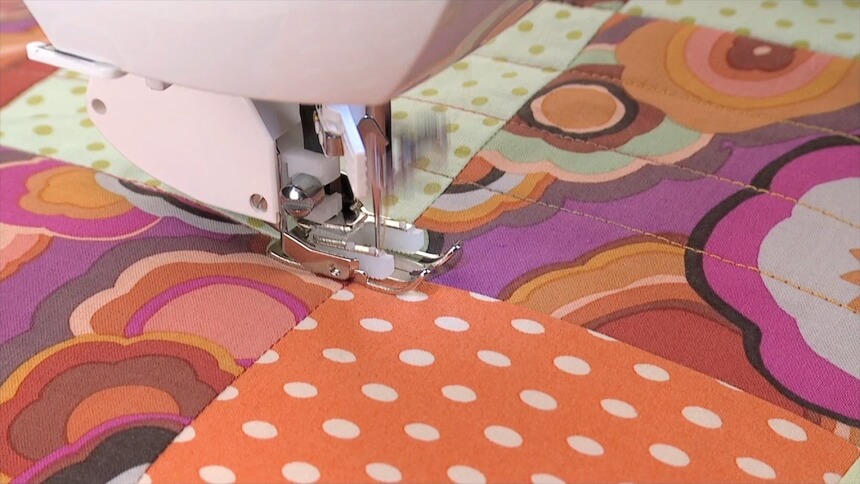

It’s not uncommon to see or hear seamsters and seamstresses rave about the walking foot sewing machine. The hype around this machine is because it gets things done better than the presser foot that comes with most sewing machines. Definitely, everyone loves anything that makes their job easier and that’s exactly what walking foot does.
Moreover, the walking foot is a specialty machine for heavy materials. So, you can count on this machine to solve sewing challenges that arise from thick layers. Essentially, it climbs up and down thick layers more easily than other feeding mechanisms and you can’t but appreciate that.
You’re probably dying to know more about the walking foot and you’re not about to be disappointed. This article will lay bare everything you need to know about this sewing machine feeding mechanism.
 What does a walking foot do? A walking foot is simply a feeding mechanism for a sewing machine. It feeds the workpiece through the machine as it’s being stitched. Of all sewing machine feet, the walking foot is arguably the most versatile because it tends to do a lot more than the others. As we hinted earlier, it is mostly used for sewing heavy materials in case the needle feed is inadequate.
What does a walking foot do? A walking foot is simply a feeding mechanism for a sewing machine. It feeds the workpiece through the machine as it’s being stitched. Of all sewing machine feet, the walking foot is arguably the most versatile because it tends to do a lot more than the others. As we hinted earlier, it is mostly used for sewing heavy materials in case the needle feed is inadequate.
Besides that, the walking foot works well in sewing materials with different layers. The bottom of the walking foot features feed dogs that help to pull the fabric through the sewing machine. Also, the foot has a lever on its side that makes the feed dogs move.
Did we remember to say that the walking foot is an attachment to your sewing machine to replace the all-purpose presser foot? Oh yes, it is. Some machines on the market come with a walking foot. If you want one, you can easily find the best walking foot sewing machine that allows you to do much more sewing.
One of such is the Singer Quantum Stylist 9985 Computerized Sewing Machine with up to 960 stitches. You get to access all of the stitches on its LCD screen. Moreover, this machine comes with a variety of accessories, including all-purpose foot, even feed/walking foot, open toe foot, amongst others.
However, other machines just come with an all-purpose foot. So, you’ll need to buy a walking foot as an attachment for a high-quality sewing machine. Such a machine could be the best Singer sewing machine or you could make your choice from the best upholstery sewing machines.
 We must mention that there are two different types of walking feet; the open toe and classic walking feet. Those are the top two options you can choose from if you want to buy one as an attachment for your sewing machine. Below, we will give some insights into the two types:
We must mention that there are two different types of walking feet; the open toe and classic walking feet. Those are the top two options you can choose from if you want to buy one as an attachment for your sewing machine. Below, we will give some insights into the two types:
Open toe: This type of walking foot is more useful when you’re machine quilting and binding because it gives you more visibility and marks. Essentially, it allows you to see precisely where the needle hits your fabric.
A reliable example of this type of walking foot is the Open Toe Walking Foot with a high-quality metallic material. The foot’s top feed dogs feed the fabric while the sewing machine’s lower feeds feed the fabric, thus providing an even result.
Classic: This type of walking foot, as its name suggests, has been around longer and offers more functions than the open toe walking foot. It also gives the fabric better support when the needle gets pushed through it. When you don’t need extra visibility, the classic walking foot is your guy.
You might have been wondering why the walking foot and feed dogs are called their names? You’re about to get some answers. The walking foot features a walking mechanism that moves your fabric (both top and bottom layers at the same pace) as they are sewn. The feed dogs, on the other hand, look like two, three, or four teethed bars that move back and forth in slots in your sewing machine’s needle plate. They use their teeth to pull or “feed” the fabric through your machine.
 If your sewing machine doesn’t come with a walking foot, the challenge for you is installing one on your machine. This isn’t a complicated process but it can be tricky. Below, we’ll run you through the steps of installing a walking foot:
If your sewing machine doesn’t come with a walking foot, the challenge for you is installing one on your machine. This isn’t a complicated process but it can be tricky. Below, we’ll run you through the steps of installing a walking foot:
Step 1 – Remove your machine’s presser foot and its holder. Ensure that you unscrew the entire foot.
Step 2 – Pick up the walking foot and slide it from behind. Put its clamp around the presser foot holder. Then, screw in the left side. Ensure that the plastic fork is set over the needle bar on the right before tightening the screw.
Step 3 – To check that the walking foot is installed properly, move the needle up and down. If it does not touch the sole’s metal, your job is done.
As we mentioned earlier, there are many ways to use the walking foot. We will explain some of them below:
 When sewing straps, it’s not uncommon for you to notice strange ripples down the workpiece. While your all-purpose presser foot won’t be able to help you prevent such issues, the walking foot is perfectly placed to help you avoid them. So, if you want to sew straps without trouble, you know what to do.
When sewing straps, it’s not uncommon for you to notice strange ripples down the workpiece. While your all-purpose presser foot won’t be able to help you prevent such issues, the walking foot is perfectly placed to help you avoid them. So, if you want to sew straps without trouble, you know what to do.
 Stretch fabrics are typically difficult to sew but their patterns are perfect. With a walking foot on your sewing machine, you can sew stretch fabrics more easily without them stretching too far.
Stretch fabrics are typically difficult to sew but their patterns are perfect. With a walking foot on your sewing machine, you can sew stretch fabrics more easily without them stretching too far.
 Every seamster or seamstress wants to finish their projects on a good note. Your regular presser foot doesn’t guarantee you a perfect binding to finish off your projects but a walking foot provides an even feed to cover the raw edges of your quilt with clean lines.
Every seamster or seamstress wants to finish their projects on a good note. Your regular presser foot doesn’t guarantee you a perfect binding to finish off your projects but a walking foot provides an even feed to cover the raw edges of your quilt with clean lines.
 We can’t mention this enough, a walking foot helps you sew multiple layers quite easily. Compared to the presser foot, the walking foot moves more smoothly over your fabric irrespective of the number of layers.
We can’t mention this enough, a walking foot helps you sew multiple layers quite easily. Compared to the presser foot, the walking foot moves more smoothly over your fabric irrespective of the number of layers.
 Sewing quilts with a walking foot keeps the layers together. It also makes the top, middle, and bottom layers to move in the same direction. This will effectively prevent puckers.
Sewing quilts with a walking foot keeps the layers together. It also makes the top, middle, and bottom layers to move in the same direction. This will effectively prevent puckers.
Seamsters and seamstresses face different challenges when sewing fabrics but using a walking foot sewing machine makes their job a whole lot easier as this article has established. Whether you’re sewing straps or you’re sewing multiple layers, the walking foot sewing machine helps you get the job done in the best way possible. As we mentioned before, you can either buy a walking foot industrial sewing machine or buy a walking foot as an attachment for your sewing machine.